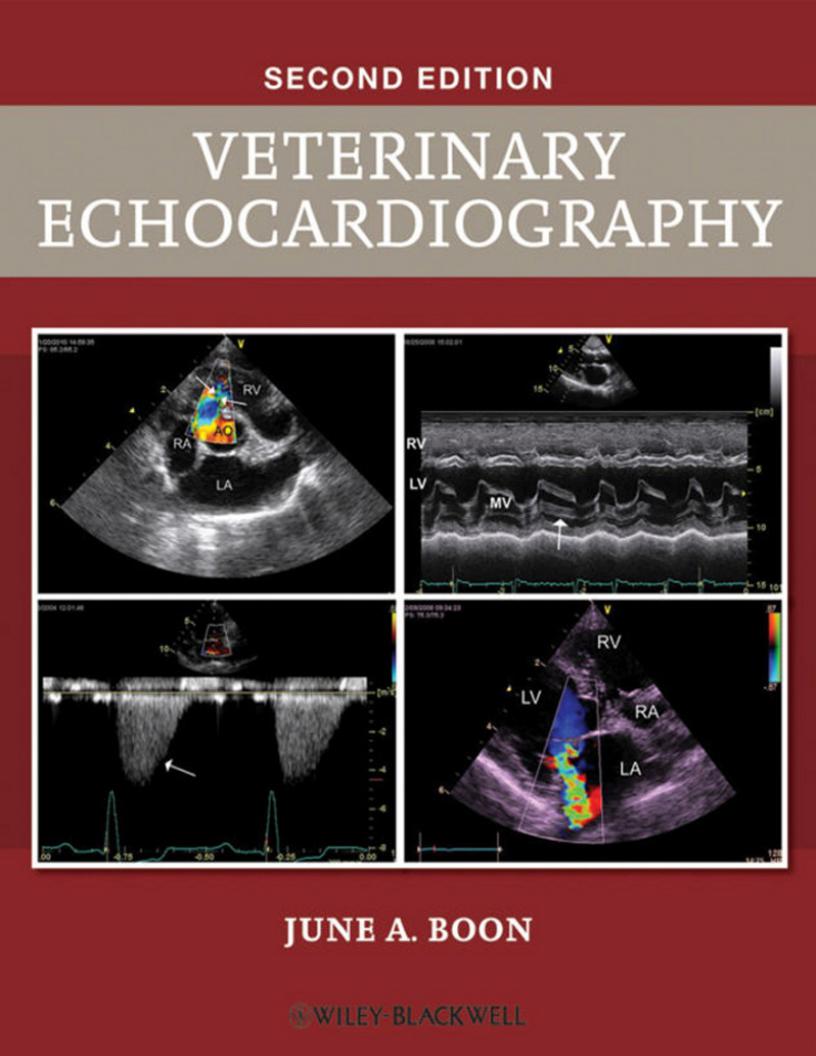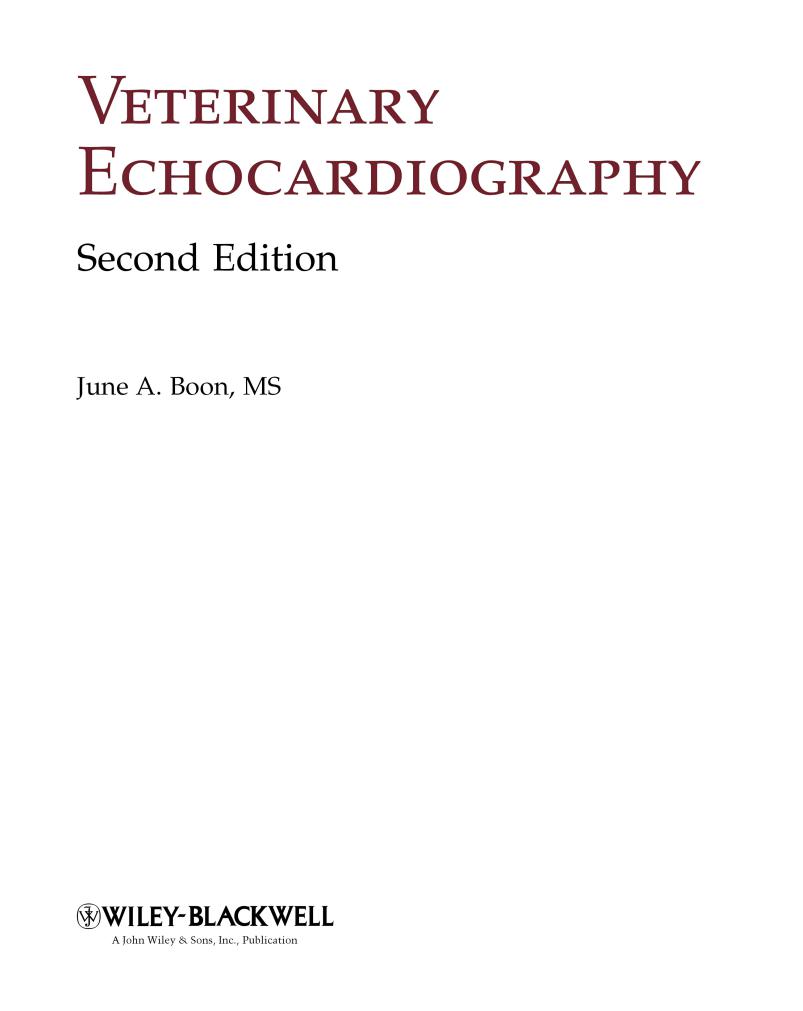
- •Preface
- •Acknowledgments
- •Basic Physics
- •Transducers and Resolution
- •Doppler Physics
- •Artifacts
- •Summary
- •Introduction
- •Patient Preparation
- •Patient Positioning
- •Transducer Selection
- •Two-Dimensional Images
- •Two-Dimensional Imaging Controls
- •Introduction
- •M-Mode Echocardiography
- •Color-Flow Doppler
- •Spectral Doppler
- •Tissue Doppler Imaging
- •Measurement and Assessment of Two-Dimensional Images
- •Measurement and Assessment of M-Mode Images
- •Measurement and Assessment of Spectral Doppler Flow
- •Measurement and Assessment of Tissue Doppler Imaging
- •Evaluation of Color-Flow Doppler
- •Evaluation of Ventricular Function
- •Mitral Regurgitation
- •Aortic Regurgitation
- •Tricuspid Regurgitation
- •Pulmonary Regurgitation
- •Endocarditis
- •Pulmonary Hypertension
- •Systemic Hypertension
- •Hypertrophic Cardiomyopathy
- •Dynamic Right Ventricular Outflow Obstruction
- •Moderator Bands
- •Dilated Cardiomyopathy
- •Right Ventricular Cardiomyopathy
- •Restrictive Cardiomyopathy
- •Endocardial Fibroelastosis
- •Arrhythmogenic Right Ventricular Cardiomyopathy
- •Myocardial Infarction
- •Myocardial Contusions
- •Pericardial Effusion
- •Neoplasia as a Cause of Pericardial Effusion
- •Pericardial Disease
- •Abscesses
- •Pericardial Cysts
- •Thrombus
- •Ventricular Septal Defect
- •Patent Ductus Arteriosus
- •Aorticopulmonary Window
- •Right to Left Shunting PDA
- •Atrial Septal Defects
- •Endocardial Cushion Defects
- •Bubble Studies
- •Atrioventricular Valve Dysplasia
- •Outflow Obstructions
- •Inflow Obstructions
- •Tetralogy of Fallot
- •APPENDIX ONE Bovine
- •APPENDIX TWO Canine
- •APPENDIX THREE Equine
- •APPENDIX FOUR Feline
- •APPENDIX FIVE Miscellaneous Species
- •Index

Table of Contents
Cover
Table of Contents
Half title page
Title page
Copyright page
Dedication
Preface
Acknowledgments
CHAPTER ONE The Physics of Ultrasound
Basic Physics
Transducers and Resolution
Doppler Physics
Artifacts
Summary
CHAPTER TWO The Two-Dimensional Echocardiographic Exam
Introduction
Patient Preparation
Patient Positioning
Transducer Selection
Two-Dimensional Images
Two-Dimensional Imaging Controls
CHAPTER THREE The M-Mode and Doppler Examination
Introduction
M-Mode Echocardiography
Color-Flow Doppler
Spectral Doppler
Tissue Doppler Imaging
CHAPTER FOUR Evaluation of Size, Function, and Hemodynamics Measurement and Assessment of Two-Dimensional Images Measurement and Assessment of M-Mode Images
Measurement and Assessment of Spectral Doppler Flow Measurement and Assessment of Tissue Doppler Imaging Evaluation of Color-Flow Doppler
Evaluation of Ventricular Function
Hemodynamic Information Obtained From Echocardiographic Exams
CHAPTER FIVE Acquired Valvular Disease
Mitral Regurgitation
Aortic Regurgitation
Tricuspid Regurgitation
Pulmonary Regurgitation
Endocarditis
CHAPTER SIX Hypertensive Heart Disease
Pulmonary Hypertension
Systemic Hypertension
CHAPTER SEVEN Myocardial Diseases
Hypertrophic Cardiomyopathy
Dynamic Right Ventricular Outflow Obstruction
Moderator Bands
Dilated Cardiomyopathy
Right Ventricular Cardiomyopathy
Restrictive Cardiomyopathy
Endocardial Fibroelastosis
Arrhythmogenic Right Ventricular Cardiomyopathy
Myocardial Infarction
Myocardial Contusions
CHAPTER EIGHT Pericardial Disease, Effusions, and Masses
Pericardial Effusion
Neoplasia as a Cause of Pericardial Effusion
Pericardial Disease
Abscesses
Pericardial Cysts
Thrombus
CHAPTER NINE Congenital Shunts and AV Valve Dysplasia Ventricular Septal Defect
Patent Ductus Arteriosus
Aorticopulmonary Window Right to Left Shunting PDA Atrial Septal Defects Endocardial Cushion Defects Bubble Studies
Atrioventricular Valve Dysplasia
CHAPTER TEN Stenotic Lesions
Outflow Obstructions
Inflow Obstructions
Tetralogy of Fallot
APPENDIX ONE Bovine
APPENDIX TWO Canine
APPENDIX THREE Equine
APPENDIX FOUR Feline
APPENDIX FIVE Miscellaneous Species
Index
VETERINARY ECHOCARDIOGRAPHY
SECOND EDITION

This edition first published 2011 © 2011 by June A. Boon
Blackwell Publishing was acquired by John Wiley & Sons in February 2007. Blackwell’s publishing program has been merged with Wiley’s global Scientific, Technical and Medical business to form Wiley-Blackwell.
Registered office: John Wiley & Sons Ltd, The Atrium, Southern Gate, Chichester, West Sussex, PO19 8SQ, UK
Editorial offices: 2121 State Avenue, Ames, Iowa 50014-8300, USA
The Atrium, Southern Gate, Chichester, West Sussex, PO19 8SQ, UK
9600 Garsington Road, Oxford, OX4 2DQ, UK
For details of our global editorial offices, for customer services and for information about how to apply for permission to reuse the copyright material in this book please see our website at www.wiley.com/wiley-blackwell.
Authorization to photocopy items for internal or personal use, or the internal or personal use of specific clients, is granted by Blackwell Publishing, provided that the base fee is paid directly to the Copyright Clearance Center, 222 Rosewood Drive, Danvers, MA 01923. For those organizations that have been granted a photocopy license by CCC, a separate system of payments has been arranged. The fee codes for users of the Transactional Reporting Service are ISBN-13: 978-0-8138-2385-0/2011.
Designations used by companies to distinguish their products are often claimed as trademarks. All brand names and product names used in this book are trade names, service marks, trademarks or registered trademarks of their respective owners. The publisher is not associated with any product or vendor mentioned in this book. This publication is designed to provide accurate and authoritative information in regard to the subject matter covered. It is sold on the understanding that the publisher is not engaged in rendering professional services. If professional advice or other expert assistance is required, the services of a competent professional should be sought.
Disclaimer
The contents of this work are intended to further general scientific research, understanding, and discussion only and are not intended and should not be relied upon as recommending or promoting a specific method, diagnosis, or treatment by practitioners for any particular patient. The publisher and the author make no representations or warranties with respect to the accuracy or completeness of the contents of this work and specifically disclaim all warranties, including without limitation any implied warranties of fitness for a particular purpose. In view of ongoing research, equipment modifications, changes in governmental regulations, and the constant flow of information relating to the use of medicines, equipment, and devices, the reader is urged to review and evaluate the information provided in the package insert or instructions for each medicine, equipment, or device for, among other things, any changes in the instructions or indication of usage and for added warnings and precautions. Readers should consult with a specialist where appropriate. The fact that an organization or Website is referred to in this work as a citation and/or a potential source of further information does not mean that the author or the publisher endorses the information the organization or Website may provide or recommendations it may make. Further, readers should be aware that Internet Websites listed in this work may have changed or disappeared between when this work was written and when it is read. No warranty may be created or extended by any promotional statements for this work. Neither the publisher nor the author shall be liable for any damages arising herefrom.
Library of Congress Cataloging-in-Publication Data
Boon, June A.
Veterinary echocardiography / June A. Boon. – 2nd ed. p. ; cm.
Rev. ed. of: Manual of veterinary echocardiography / June A. Boon. ©1998. Includes bibliographical references and index.
ISBN 978-0-8138-2385-0 (hardcover : alk. paper)
1. Veterinary echocardiography. I. Boon, June A. Manual of veterinary echocardiography. II. Title. [DNLM: 1. Echocardiography–veterinary. SF 811]
SF811.B66 2011 636.089´61207543–dc22 2010028092
A catalogue record for this book is available from the British Library.
This book is published in the following electronic formats: ePDF 9780470958841; ePub 9780470958919
For the people who make my life rich and bring joy to my days:
Dave—my best friend and soul mate for 23+ years—thank you for all you do—I love you Denali and Logan—you have both become such exceptional individuals
Reuben—I am so glad you are part of our family Mike and Stephan—I could not be prouder of you guys
Preface
When I started this project, I thought it would be easy. The first 20 years of veterinary echocardiography were done; I simply had to write about new developments over the past ten years. It was not so easy. The past ten years have brought with it significant advances in technology including better transducers, tissue harmonic imaging, better color flow mapping, and color and spectral tissue Doppler imaging. The echocardiographic examination now provides so much more information than it did 10 years ago. The amount of information continues to grow exponentially – because of and thanks to the many cardiologists who have been trained, certified and working to expand our knowledge over this past decade.
The format of this edition is different from the previous one in the hope that it makes this book easier to use. Chapter 1, a necessary evil, still covers the pertinent physical principles of sound that allow us to use ultrasound as a diagnostic tool. Chapters 2 and 3 describe the two dimensional, m- mode and Doppler examinations. All imaging planes are described with instructions and pictures for obtaining these images. I have included images of common mistakes and directions for fixing them. After all these years, I still find myself discovering little pearls of wisdom about obtaining and evaluating certain imaging planes. This is a skill that continuously develops, so don’t give up. With this in mind, I would like to acknowledge Dr. Jim Woods – creator of Woods’ Criteria - for reminding me that a study does not need to be perfect in order to obtain valuable information. Assessment of the echocardiographic examination is covered in Chapter 4. This chapter describes how to measure, and interpret the ultrasound examination. It describes the application of each parameter in a general way. It also tells of the factors that influence their interpretation, factors like heart rates, age, blood pressure, preload and afterload. The chapters following this cover the echocardiographic features of the most common cardiac diseases seen in veterinary medicine. Chapter 5 discusses acquired valvular diseases. Chapter 6 describes the features of systemic and pulmonary hypertension. Chapter 7 deals with all of the myopathies seen in animals. Pericardial effusion and cardiac masses are described in Chapter 8. Congenital shunts and stenotic lesions are covered in Chapters 9 and 10.
I have as usual probably overdone the references that are included in each chapter. Many offer viewpoints form the human side of echocardiography. I hope that this comprehensive reference list provides insight into the how and why of echocardiographic parameters and interpretation. I also hope that they spark some new ideas. I continue to learn every day, and this is what keeps me interested and loving what I do.
As with the first edition, it is my sincere wish that this book provides a comprehensive reference and instruction manual for echocardiographers at all levels of experience.
Acknowledgments
My sincere gratitude goes to Dr. Chris Orton and Dr. Jan Bright for their support in my endeavors. I couldn’t ask for better people to work with and have as mentors.
I would also like to acknowledge all of the cardiology residents that I have had the pleasure of working with over the past 10 years: Julie Martin, Sarah Zimmerman, TJ Morrison, Leigh Griffiths, Sarah Scruggs, Cassidy Sedacca, and Holly MacLea. I have become a better teacher because of you, and you have kept me on my toes. Many images in this book are from studies you have obtained, and I am thankful for your dedication to creating excellent echocardiographic studies.
June A. Boon

CHAPTER ONE
The Physics of Ultrasound
Cardiac ultrasound, echocardiography, permits noninvasive and nonionizing visualization of the inside of the heart including the aorta, the ventricles and atria, the auricular appendages, and all of the cardiac valves. Dynamic images of the contracting heart are created with two-dimensional and motion mode (M-mode) images while blood flow through the heart can be seen and measured with Doppler ultrasound. Tissue Doppler imaging allows analysis of myocardial motion. Defects including valvular lesions, cardiac shunts, cardiac and thoracic masses, pleural and pericardial effusions, myocardial diseases, and stenotic lesions can be seen. More importantly it allows assessment of cardiac chamber sizes, cardiac function, blood flow, and myocardial motion, which provides information on hemodynamic status and extent of the disease process.
Uses of Echocardiography
See internal cardiac structures.
Evaluate function.
Evaluate size.
See defects.
Valvular lesions
Shunts
Myocardial abnormalities
Masses
Effusions
Stenotic lesions
Evaluate blood flow.
Assess myocardial motion and function.
All of this is possible because of sound. Sound is sent into the body and reflected from soft tissue structures. The reflected sound waves are analyzed, and an image is generated on a monitor. Sending out many sound waves side by side will produce an image with depth and width. The result is a twodimensional image (Figure 1.1). When the sound waves are continuously and rapidly sent out in sequence, many two-dimensional images can be generated per minute, and a moving image of the heart is made called real-time or B-mode ultrasound. By sending out only one sound beam instead of many, only the structures associated with that one beam are seen, producing an M-mode image (Figure 1.2). The structures associated with that one line through the heart keep scrolling on the screen as the heart continues to contract and relax. The M-mode image displays depth on the vertical axis and time along the horizontal axis.
Figure 1.1 Many sound waves sent into the body side by side will create an image with depth and width. The result is a two-dimensional echocardiographic image. This is a right parasternal long-axis four-chamber view of the heart. RV = right ventricle, TV = tricuspid valve, RA = right atrium, IVS = interventricular septum, LV = left ventricle, LVW = left ventricular wall, LA = left atrium, MV = mitral valve, CT = chordae tendineae.

Figure 1.2 When one of the sound beams used to create the two-dimensional image is selected to generate an M-mode image, only the structures associated with that one beam are seen. The twodimensional image at the left side of this figure shows a cursor representing the one beam. A onedimensional M-mode image is created from the structures the cursor crosses. The vertical axis represents depth while the horizontal axis represents time. Here the structures of the left ventricle are seen on the M-mode to the right as they change throughout a cardiac cycle. RV = right ventricle, IVS = interventricular septum, LV = left ventricle, LVW = left ventricular wall, AO = aorta, LA = left atrium.
Doppler is used in diagnostic ultrasound to provide information on blood flow (spectral and colorflow Doppler) or myocardial motion (tissue Doppler imaging [TDI]) of the heart and its vessels. Specific locations within the heart can be selected and a spectral display of blood flow or muscle motion is created. As in M-mode the horizontal axis represents time while the vertical axis represents velocity (Figure 1.3).
